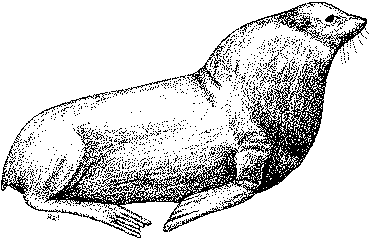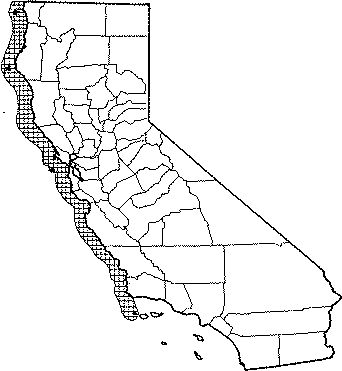
Northern Sea Lion
Distribution, Abundance, and Seasonality
Relatively uncommon today, although it was the most abundant pinniped in southern California in the early 1900's (Bonnot 1928). Infrequently observed at sea, hauls out on land in small to moderate-sized groups on coastal islands, and occasionally on offshore rocks along the mainland. Breeding rookeries are located at Ano Nuevo Island (San Mateo Co.), Farallon Islands, Pt. Saint George (Del Norte Co.), and Sugarloaf on Cape Mendocino. Ano Nuevo Island supports the largest breeding colony; over 800 breed here each year (Le Boeuf 1981). While the population has remained comparatively stable in northern California, it has decreased on the Channel Islands since the 1930's when 2000 bred on San Miguel Island. Today, only a few remain on San Miguel Island during the breeding season. The cause of this population decrease is unclear, although increasing water temperatures may be a factor (Bartholomew 1967, Le Boeuf and Bonnell 1980). The entire California population estimated at 1700 by Daugherty (1979) and 4000 by Maser et al. (1981). Pup production at all rookeries has declined by 30% over the past few years, while the number of adults and juveniles has slightly increased (Pierson et al. 1981).

Range Map
Specific Habitat Requirements
Feeding: Feeds opportunistically in nearshore waters on a variety of fish, cephalopods, crustaceans, and other invertebrates. Various fish are consumed including rockfish, flatfish, anchovy, and hake. Forages singly on non-schooling prey or in small groups; large feeding groups occur in sizeable schools of fish or squid (Fiscus and Baines 1966, Gentry 1970, Morejohn 1977).
Cover: The northern sea lion hauls out on sloping shale rock outcroppings, offshore rocks, and sometimes on cobblestone or sandy beaches on coastal islands and along a few mainland sites.
Reproduction: Breeding activities take place on land in rocky areas easily accessible to water. Isolated, undisturbed sites are preferred. Females periodically leave their pups during 1-3 day feeding trips at sea (Gentry 1970, Schusterman 1981).
Water: Freshwater apparently is derived through metabolic processes, and fluids from prey consumed. During the breeding season, fasting territorial males ingest saltwater to supplement metabolically-produced water from fat stores (Gentry and Withrow 1978, Gentry 1981).
Pattern: Prefers offshore haul-out and breeding sites with unrestricted access to water, near aquatic food supply in areas of minimal human disturbance; disturbed or frightened by human presence.
Species Life History
Activity Patterns: Active yearlong; circadian pattern. During daylight, more individuals are hauled out in afternoon than morning. This species tends to remain at sea during stormy weather (Kenyon and Rice 1961).
Seasonal Movements / Migration: After breeding season in late summer, a northward migration of males and some females occurs (Maser et al. 1981, Schusterman 1981).
Home Range: No information found.
Territory: During the breeding season, adult males maintain territories on land with highly stable and well-defined boundaries. Preferred territories are sheltered and easily accessible to water. Successful bulls may breed on the same territory for up to 6 consecutive seasons (Gentry 1970).
Reproduction: Breeds May to August; peak pupping occurs mid-June. Highly polygynous; males establish and remain or territories throughout the breeding season, fasting up to 3-4 mo. Breeding territories may include 10-20 females. The majority of females give birth annually to a single pup soon after arrival, then ovulate and mate once 10-14 days following parturition (Orr and Poulter 1967, Gentry 1970). Gestation is 11 mo with a 3.5 mo interval of delayed implantation (Harrison 1969). Mothers leave their pup after mating, making progressively longer feeding trips at sea, and returning at regular intervals to nurse. Lactation continues for several mo often up to 1 yr; weaning occurs between September and June, although females with and without newborns occasionally are seen nursing yearlings also (Schusterman 1981). Females mature at 3-4 yr, with peak pup production from 7-14 yr. Males mature at 4-5 yr, but do not establish breeding territories until 9-15 yr. Premature stillbirths accounted for 35.7% of all births. Mortality of pups was 42.9% on the Farallon Islands (Ainley et al. 1977).
Niche: Preyed on by great white sharks although less often than phocids in California (Le Boeuf et al. 1982). Leptospirosis and sea lion virus occur and may be associated with premature pupping (Maser et al. 1981).
Comments: Overall abundance stable, though California populations have declined. The eastern Aleutians also experienced a decline from 1957-1977 (Braham et al.1980). Competition with commercial fisheries, leptospirosis, and shifts in species distribution have been suggested reasons for decline. Also known as Steller sea lion (Loughlin et al. 1987).
Sources & References
California Department of Fish and Game, 1999.
California's Wildlife, Sacramento, CA.
Written by: M. L. Riedman, reviewed by: H. Shellhammer, edited by: J. Harris, R. Duke
Ainley, D. G., H. R. Huber, and R. P. Henderson. 1977. Studies of marine mammals at the Farallon Islands, California, 1975-76. U.S. Marine Mammal. Comm. 75/02. 32pp. Bartholomew, G. A. 1967. Seal and sea lion populations of the California Islands. Pages 227-244 in R. N. Philbrick, ed. Proceedings of the symposium on the biology of the California Islands. Santa Barbara Botanic Garden, Santa Barbara, Calif. 363pp. Bonnot, P. 1928. The sea lions of California. Calif. Fish and Game 14:1-16. Braham, H. W., R. D. Everitt, and D. J. Rugh. 1980. Northern sea lion population decline in the eastern Aleutian Islands. J. Wildl. Manage. 44:25-33. Daugherty, A. E. 1979. Marine mammals of California. Calif. Dep. Fish and Game, Sacramento. 61pp. Fiscus, C. H., and G. A. Baines. 1966. Food and feeding behavior of Stellar and California sea lions. J. Mammal. 47:195-200. Gentry, R. L. 1970. Social behavior of the Steller sea lion. Ph.D. Thesis, Univ. California Santa Cruz. 113pp. Gentry, R. L. 1981. Northern fur seal-Callorhinus ursinus. Pages 143-160 in S. H. Ridgway and R. J. Harrison, eds. Handbook of marine mammals, Vol. 1. Academic Press, London. 235pp. Gentry, R. L., and D. E. Withrow. 1978. Steller sea lion. Pages 166-171 in D. Haley, ed. Marine mammals of Eastern North Pacific and Arctic waters. Pacific Search Press, Seattle, Wash. 256pp. Harrison, R. J. 1969. Reproduction and reproductive organs. Pages 253-348 in H. T. Andersen, ed. The biology of marine mammals. Academic Press, New York. 511pp. Kenyon, K. W., and D. W. Rice. 1961. Abundance and distribution of the Steller sea lion. J. Mammal. 42:223-234. Le Boeuf, B. J. 1981. Mammals. Pages 187-325 in B. J. Le Boeuf and S. Kaza, eds. The natural history of Ano Nuevo. Boxwood Press, Pacific Grove, Ca. 425pp. Le Boeuf, B. J., and M. L. Bonnell. 1980. Pinnipeds of the California islands: abundance and distribution. Pages 475-493 in D. Power, ed. The California islands. Santa Barbara Mus. Nat. Hist. 787pp. Le Boeuf, B. J., M. L. Riedman, and R. S. Keyes. 1982. White shark predation on pinnipeds in California coastal waters. Fish. Bull. 80:891-895. Loughlin, T. R., M. A. Perez, and R. L. Merrick. 1987. Eumatopias jubatus. Mammal. Species No. 283. 7pp. Maser, C., B. R. Mate, J. F. Franklin, and C. T. Dyrness. 1981. Natural history of Oregon coast mammals. Pac. Northwest For. And Range Exp. Sta., USDA, For. Serv., Gen. Tech. Rep., PNW-133. 496pp. Morejohn, G. V. 1977. Feeding ecology of marine mamals in Monterey Bay, California. Abstract. Page 61 in Proc. second conf. on the biology of marine mammals, San Diego, Calif. Orr, R. T., and T. C. Poulter. 1967. Some observations on reproduction, growth and social behavior in the Steller seal lion. Proc. Calif. Acad. Sci. 35:193-226. Pierson, M. O., M. L. Bonnell, and R L. Gentry. 1981. Northern sea lion (Eumetopias jubatus) breeding status in California. Page 94 (abstract) in Proc. of the Fourth Biennial Conf,. on the Biology of Marine Mammals. San Francisco, Calif. 127pp. Pitcher, K. W., and D. G. Calkins,. 1981. Reproductive biology of Steller sea lions in the Gulf of Alaska. J. Mammal. 62:599-605. Sandegren, F. E. 1976. Courtship display, agonistic behavior and social dynamics in the Steller sea lion (Eumetopias jubatus). Behavior 57:159-172. Schusterman, R. J. 1981. Steller sea lion-Eumetopias jubatus. Pages 119-141 in S. H. Ridgway and R. J. Harrison, eds. Handbook of marine mammals, vol. 1. Academic Press, London. 235pp. United States National Marine Fisheries Service. 1981. Marine Mammal Protection Act of 1972. Annual Report 1980/1981. Washington, DC. 143pp.
California Animal Facts | California's Wildlife